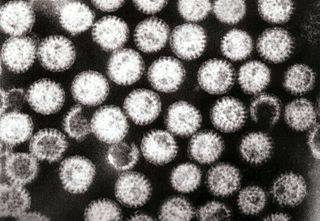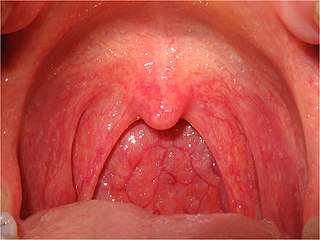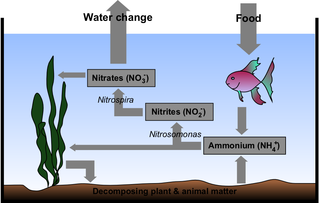
Diarrhea, also spelled diarrhoea, is the condition of having at least three loose, liquid, or watery bowel movements each day. It often lasts for a few days and can result in dehydration due to fluid loss. Signs of dehydration often begin with loss of the normal stretchiness of the skin and irritable behaviour. This can progress to decreased urination, loss of skin color, a fast heart rate, and a decrease in responsiveness as it becomes more severe. Loose but non-watery stools in babies who are exclusively breastfed, however, are normal.

Sore throat, also known as throat pain, is pain or irritation of the throat. Usually, causes of sore throat include

Ichthyophthirius multifiliis, often termed "Ich", is a parasitic ciliate described by the French parasitologist Fouquet in 1876. Only one species is found in the genus which also gave name to the family. The name literally translates as "the fish louse with many children". The parasite can infect most freshwater fish species and, in contrast to many other parasites, shows very low host specificity. It penetrates gill epithelia, skin and fins of the fish host and resides as a feeding stage inside the epidermis. It is visible as a white spot on the surface of the fish but, due to its internal microhabitat, it is a true endoparasite and not an ectoparasite.

Travelers' diarrhea (TD) is a stomach and intestinal infection. TD is defined as the passage of unformed stool while traveling. It may be accompanied by abdominal cramps, nausea, fever, headache and bloating. Occasionally bloody diarrhea may occur. Most travelers recover within three to four days with little or no treatment. About 10% of people may have symptoms for a week.
Fin rot is a symptom of disease or the actual disease in fish. This is a disease which is most often observed in aquaria and aquaculture, but can also occur in natural populations.
Bacillary dysentery is a type of dysentery, and is a severe form of shigellosis. It is associated with species of bacteria from the family Enterobacteriaceae. The term is usually restricted to Shigella infections.

Balantidiasis is a protozoan infection caused by infection with Balantidium coli.

Aquarium fish feed is plant or animal material intended for consumption by pet fish kept in aquariums or ponds. Fish foods normally contain macronutrients, trace elements and vitamins necessary to keep captive fish in good health. Approximately 80% of fishkeeping hobbyists feed their fish exclusively prepared foods that most commonly are produced in flake, pellet or tablet form. Pelleted forms, some of which sink rapidly, are often used for larger fish or bottom feeding species such as loaches or catfish. Some fish foods also contain additives such as sex hormones or beta carotene to artificially enhance the color of ornamental fish.

The common goldfish is a breed of goldfish with no other differences from its living ancestor, the Prussian carp, other than its color and shape. Goldfish are a form of domesticated wild carp and are a close relative of koi. Most varieties of fancy goldfish were derived from this simple breed. Common goldfish come in a variety of colors including red, orange, red/white, white/black, yellow/white, blue, grey/brown/, olive green, yellow, white, and black, with the most common variation being orange, hence the name. Sometimes, the brightness, duration, and vividness of the color may be an indication of the fish's health status, but not always, as manifold waters conditions facilitate the apparent discoloration.

Cryptocaryon irritans is a species of ciliates that parasitizes marine fish, causing marine white spot disease or marine ich. It is one of the most common causes of disease in marine aquaria.
Antiprotozoal agents is a class of pharmaceuticals used in treatment of protozoan infection.

Ornamental fish kept in aquariums are susceptible to numerous diseases. Due to their generally small size and the low cost of replacing diseased or dead fish, the cost of testing and treating diseases is often seen as more trouble than the value of the fish.

Dropsy is a condition in fish caused by the buildup of fluid inside the body cavity or tissues. As a symptom rather than a disease in its own right, it can indicate a number of underlying diseases, including bacterial infections, parasitic infections, or liver dysfunction.

Columnaris (also referred to as cottonmouth) is a symptom of disease in fish which results from an infection caused by the Gram-negative, aerobic, rod-shaped bacterium Flavobacterium columnare. It was previously known as Bacillus columnaris, Chondrococcus columnaris, Cytophaga columnaris and Flexibacter columnaris. The bacteria are ubiquitous in fresh water, and cultured fish reared in ponds or raceways are the primary concern – with disease most prevalent in air temperatures above 12–14 °C. It is often mistaken for a fungal infection. The disease is highly contagious and the outcome is often fatal. It is not zoonotic.

Protozoan infections are parasitic diseases caused by organisms formerly classified in the kingdom Protozoa. They are usually contracted by either an insect vector or by contact with an infected substance or surface and include organisms that are now classified in the supergroups Excavata, Amoebozoa, SAR, and Archaeplastida.
Melafix is a brand of aquarium medicine made by Mars Fishcare, marketed as a natural remedy for bacterial infections, made from cajeput oil.

Swim bladder disease, also called swim bladder disorder or flipover, is a common ailment in aquarium fish. The swim bladder is an internal gas-filled organ that contributes to the ability of a fish to control its buoyancy, and thus to stay at the current water depth without having to waste energy in swimming. A fish with swim bladder disorder can float nose down tail up, or can float to the top or sink to the bottom of the aquarium.
In biology, a pathogen in the oldest and broadest sense, is any organism or agent that can produce disease. A pathogen may also be referred to as an infectious agent, or simply a germ.
Amyloodinium ocellatum is a cosmopolitan ectoparasite dinoflagellate of numerous aquatic organisms living in brackish and seawater environments. The dinoflagellate is endemic in temperate and tropical areas, and is capable of successfully adapting to a variety of different environments and to a great number of hosts, having been identified in four phyla of aquatic organisms: Chordata, Arthropoda, Mollusca and Platyhelminthes. Moreover, it is the only dinoflagellate capable of infecting teleosts and elasmobranchs.

Sparicotyle chrysophrii is a species of monogenean, parasitic on the gills of the marine fish. It belongs to the family Microcotylidae. Its type-host is the gilt-head seabream.













